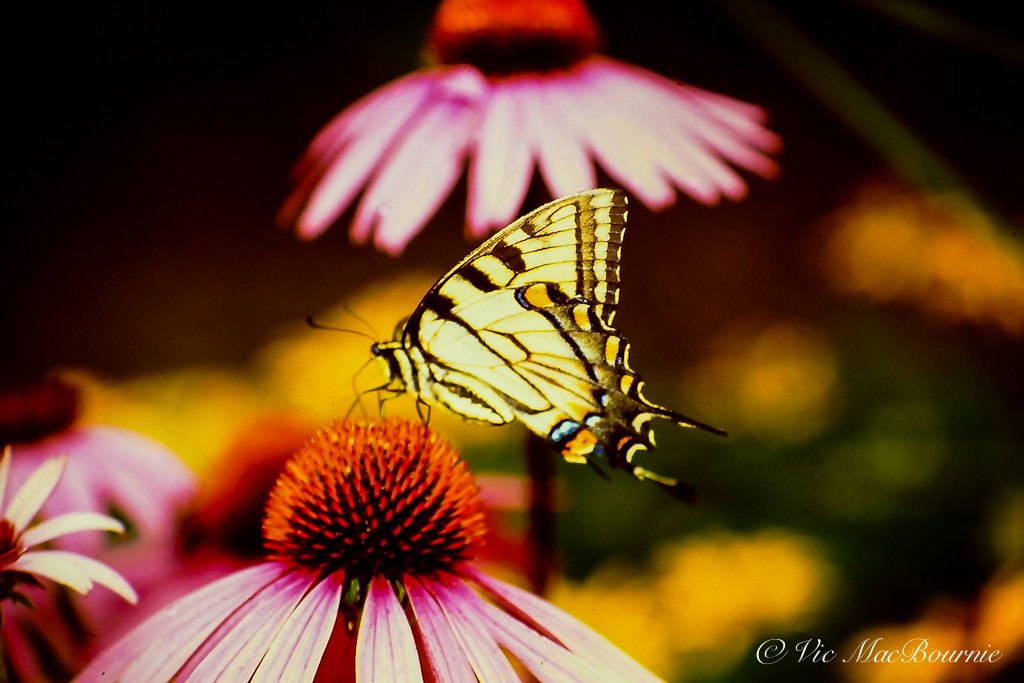How to attract Giant Tiger Swallowtail to your garden
If the Monarch is the queen of garden butterflies, the black and yellow Giant Eastern Tiger Swallowtails are surely the kings.
In our garden, Swallowtails are certainly more numerous than Monarchs during the summer. I see them fluttering about checking out our Coneflowers, Black-eyed Susans and any other safe flowering landing spot they can find. Some specimens are just spectacular boasting a wingspan of between 3.1 to 5.5 inches (7.9 to 14 cm).
The Giant Swallowtail is the largest butterfly in Canada and parts of the United States. In Canada, it is only native at the southwestern tip of Ontario but has been seen as far North as Winnipeg, Manitoba. In the north, they are common from May to September. In the eastern United States, the Tiger Swallowtail is one of the most familiar butterflies, but its range stretches from southern Vermont to Florida west to eastern Texas and the Great Plains.
Females are larger than males and Tiger Swallowtails in the south tend to be larger than those in more northern regions.
Male yellow Tiger Swallowtails have four black “tiger stripes” on each of its forewings. The females, which can be yellow or black, have wings with strong, almost florescent, splashes of blue running across the back end of its wings.
Swallowtails, unlike the Monarch butterfly that depends on milkweed as a host plant, are generalists although they like to lay their eggs on citrus trees in the south and the more common Hop tree and Northern Prickly Ash in more northern regions. Gas Plant and common rue (Ruta graveolens) are also two plants that the larvae use as a host plant.
The caterpillar will pupate in early summer into a well camouflaged chrysalis. After about 12 days, the butterfly emerges. A chrysalis that forms in late fall will not hatch until late spring preferring to overwinter in the debris of our gardens.
This is the reason we do NOT clean up our gardens in the fall or early spring.
Farther south in warmer climates, it’s possible to have three successful hatches.
A single green egg is laid on a plant prior to the birth of a small caterpillar. As the caterpillars age they turn green with two black, yellow, and blue eyespots on the thorax.
The caterpillar turns brown prior to pupating. It will reach a length of 5.5 centimetres (2.2 in). The chrysalis varies from a whitish color to dark brown. Hibernation occurs in this stage in locations with cold winter months.
How to attract Eastern Tiger Swallowtails to your garden
Although Swallowtails are primarily woodland butterflies, other common habitats include open fields, rivers, creek beds, roadsides and, of course, our gardens.
Attracting the giant butterflies to your garden is not difficult providing you ensure at least some of the contributing habitat factors – food for all stages of the butterfly from larvae through to adulthood, a source of shallow water or puddle, and some form of shelter such as a woodpile, tall grasses or bushes where they can disappear to at night.
Food for Swallowtail larvae
Both the caterpillars and the butterflies of both the Eastern variety and the Western variety of Tiger swallowtails can be considered generalists, feeding on a wide variety of plants.
Common host plants used are those of the families Magnoliaceae and Rosaceae, with species like the tulip tree (Liriodendron tulipifera), sweet bay magnolia (Magnolia viginiana) and wild black cherry (prunus serotina). Aspens, Alders, birches, cottonwoods and willows are also host plants in more northern regions.
The Spicebush swallowtail is very similar to the black Eastern Tiger Swallowtail, although it is actually mimicking a poisonous Piper Swallowtail.
But, plant a nice sweep of parsley in a quiet corner of your yard and you are instantly on the right track to attract black Swallowtail caterpillars. Parsley is one of the key host plants for the caterpillars that are also happy to dine on fennel, dill, Queen Anne’s lace and other members of the carrot family.
The butterflies themselves are not overly selective on what flower they will land on to get nectar.
Here are a few good choices that will give you bloom throughout the summer. Adult butterflies use a wide range of food sources, most preferring to nectar on plants with red or pink flowers. As mentioned earlier, purple coneflower Salvias and Black-Eyed Susans provide ideal landing areas for the large butterflies to enjoy a meal, but other nectar sources include:
Bee Balm (Monarda)
Blazing Star (Liatris spicata)
Butterfly Weed (Asclepias tuberosa)
Blanket flower (Gaillardia)
Joe-Pye Weed (Eupatorium purpureum)
Penta (Pentas lanceolata)
Garden Phlox (Phlox paniculata)
Why do Swallowtails use puddles?
It is mostly males that gather at puddles either singularly or in numbers. These puddles can be formed in mud or damp gravel and are used by the butterflies to extract sodium ions and amino acids to aid in reproduction.
Females only occasionally puddle and most often are seen alone at the puddle.
In our garden, I like to use a very shallow hanging birdbath as a puddler for butterflies, but you can purchase commercial puddlers to accommodate the butterflies.
You can add some slices of fruit (bananas, oranges) to the shallow puddle to attract even more varieties of butterflies.



